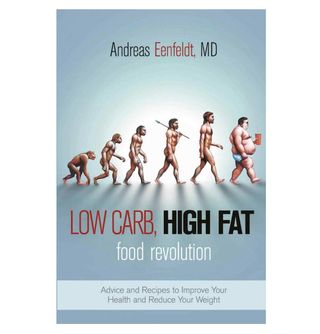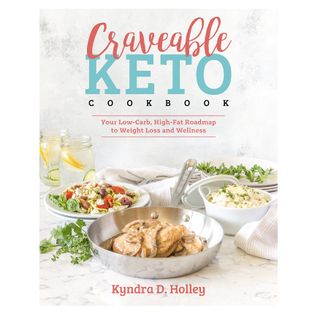What You Need to Know Before Trying a Low-Carb, High-Fat Diet
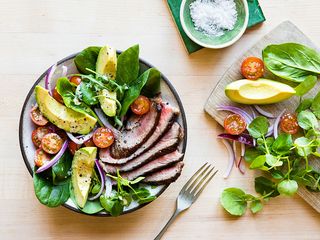
If we had to name a definitive diet trend of 2019, it would be the low-carb, high-fat diet. Colloquially known as the keto diet, this eating approach nearly eliminates carbohydrates and prioritizes foods high in fat and protein.
More specifically, a standard low-carb, high-fat diet calls for "obtaining less than 50% of your daily calories from carbohydrates," Bethany M. Doerfler, a clinical research dietitian at Northwestern Medicine, told U.S. News & World Report. "Fat intake ranges from between 30% to 40% of daily caloric intake, and protein consumption might land in the 10% to 30% daily range." Compare this to The Institute of Medicine's recommendation, which asks that U.S. adults get 45% to 65% of their daily calories from carbs, 20% to 35% from fat, and 10% to 35% from protein.
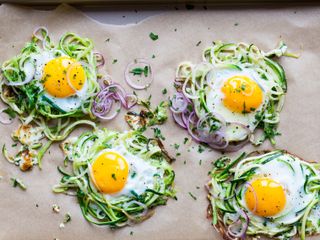
The goal is to replace carbohydrates with satiating healthy fats like avocado, olive oil, and salmon, ideally eliminating the hunger pangs associated with typical dieting. But keep in mind that in stricter iterations of the diet, beans, quinoa, chickpeas, corn, and more are considered high-carb.
Is a Low-Carb, High-Fat Diet Good for You?

Like any of-the-moment diet, the jury's still out as to whether or not a low-carb, high-fat diet is truly healthy, especially in the long-term.
Naysayers argue that any diet that eliminates a food group entirely can't be healthy. It makes for an unsustainable eating approach and can lead to nutritional deficiencies. Studies have also found that low-carb, high-fat diets, which tend to be heavy in meat and naturally fatty foods like avocados and butter, can lead to cholesterol issues and constipation.
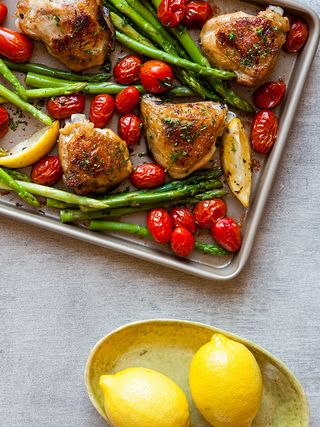
On the other side of the coin, research suggests that a low-carb, high-fat diet can offer some health benefits, especially if you consider weight loss a benefit. As Harvard Health reports, "there is some evidence that a low-carbohydrate diet may help people lose weight more quickly than a low-fat diet—and may help them maintain that weight loss." The studies Harvard references pertain specifically to obese men and women.
Anecdotally speaking, benefits include reduced appetite, loss in harmful abdominal fat, and protection against metabolic syndrome. More research is needed across the board to assess the true health and efficacy of low-carb, high-fat diets.
Foods to Eat

First and foremost, you should consult a dietitian or nutritionist before diving headfirst into a low-carb, high-fat diet. A professional will help you formulate an eating plan that provides the nutrients your body needs while helping you meet your health goals. Prior to that discussion, here's a general outline of what to eat on a low-carb, high-fat diet:
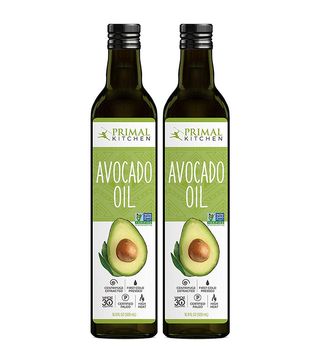
"Good" Fats
Avocado oil, chia seed, olive oil, coconut oil, fish oil, pumpkin seed oil, sesame oil, ghee, grass-fed butter, bacon fat, lard, flaxseeds.

Animal Protein
Beef, eggs, chicken, fish, bacon, pork, lamb, venison, sausage, bison, salami, veal. Eat organic, grass-fed, and wild-caught whenever possible.
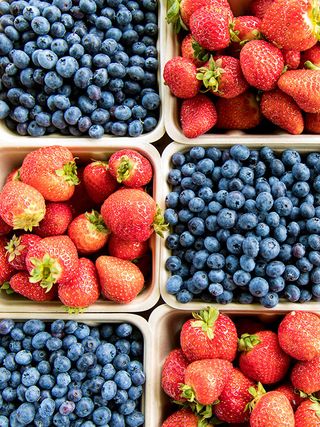
Fruits and Vegetables
Avocado, berries, coconut, lime, lemon, olives, rhubarb, lettuce, arugula, spinach, celery, cucumber, avocado, artichoke, radishes, okra, snow peas, eggplant, onions, asparagus, green beans, brussels sprouts, mushrooms, peppers, tomatoes, spaghetti squash, scallions, shallots, zucchini, cabbage, broccoli, cauliflower.

Dairy
Full-fat cheeses, soft cheeses, heavy cream, full-fat Greek yogurt, sour cream.
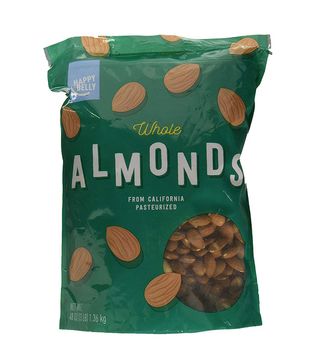
Nuts and Seeds
Almonds, Brazil nuts, flaxseeds, hazelnuts, hemp seeds, macadamia nuts, pecans, pumpkin seeds, sunflower seeds, sesame seeds, walnuts.
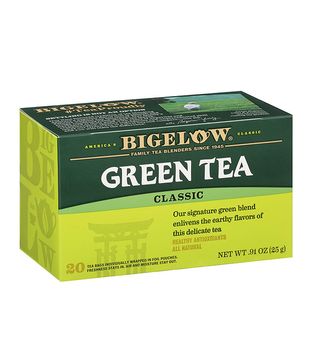
Drinks and Alcohol
Black tea, green tea, herbal tea, bone broth, coffee, water, red wine, white wine, brandy, gin, rum, tequila, vodka, whiskey.
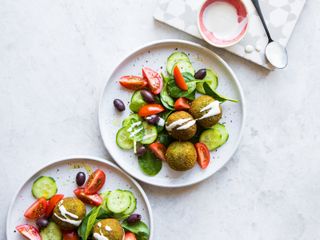
Foods to Limit

Generally speaking, you should stick to whole, natural foods and limit processed and packaged foods, artificial sweeteners, refined sugars, fried foods, fat-free or low-fat dairy products, and sugary sodas. This goes for pretty much any healthy, nutritionally sound diet.
"Bad" Fats
Canola oil, corn oil, grape-seed oil, flaxseed oil, hemp oil, margarine, safflower oil, soybean oil, sunflower oil, vegetable oil.
Animal Protein
Canned meats, cured meats, processed deli meats.
Fruits and Vegetables
Technically, the following fruits and vegetables are considered "high-carb": bananas, apples, grapes, pears, pineapples, potatoes, sweet potatoes, corn, pumpkin, butternut squash, yams, and peas.
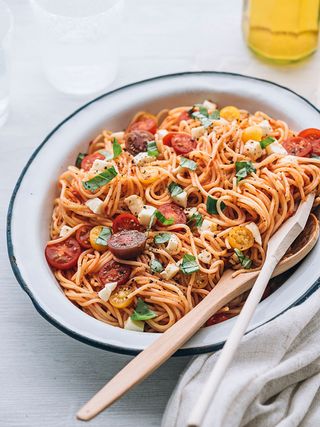
Grains and Starches
Barley, beans, bread, breakfast cereals, buckwheat, bulgar wheat, chickpeas, couscous, lentils, legumes, muesli, oats, pasta, quinoa, rice, rye, wheat flour.
Sweets and Snacks
Agave, biscuits, cake, chocolate, cookies, doughnuts, dried fruit, ice cream, pancakes, pastries, puddings, soda, chips.
Drinks and Alcohol
Soda, beer, cider, sweet liqueurs.
Do Your Research
Want to learn more? Here are a few books that can help.
Disclaimer
This article is provided for informational purposes only and is not intended to be used in the place of advice of your physician or other medical professionals. You should always consult with your doctor or healthcare provider first with any health-related questions.
Kelsey Clark is a freelance writer and content strategist based in Detroit. She got her start in editorial in New York City as MyDomaine's lifestyle editor and has since gone full-time freelance. She now contributes to Who What Wear, THE/THIRTY, Domino, Glamour, The Zoe Report, Apartment Therapy, and more, in addition to working with brands such as Bloomscape and EyeSwoon on content strategy and copywriting. She's written about fashion, interior design, health and wellness, pop culture, food, travel, politics, and professional development, but she'd consider the first three verticals her main "beats." She's also incredibly passionate about mental health awareness and hopes to help eradicate the social stigma through storytelling and education. When she's not writing, you can find her scouring thrift stores for Levi's 501s, picking up a new vintage piece for her apartment, or exploring new restaurants and bars across Detroit.
-
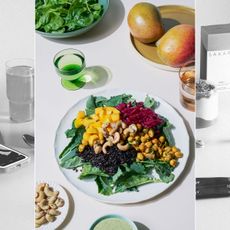 I Only Ate Sakara Life Meals for 30 Days—Here Are 7 Things That Happened
I Only Ate Sakara Life Meals for 30 Days—Here Are 7 Things That HappenedThe brand's 30-Day Fall Reset is finally here.
By Erin Jahns
-
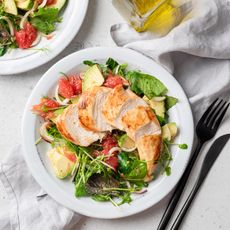 The 6 Warning Signs You're Not Getting Enough Protein
The 6 Warning Signs You're Not Getting Enough ProteinAnd what to eat to up your intake.
By Sarah Yang
-
 Everything This Professional Ballet Dancer Eats to Fuel Her For Performances
Everything This Professional Ballet Dancer Eats to Fuel Her For PerformancesHer grocery staples include high-quality French butter.
By Candice Aman
-
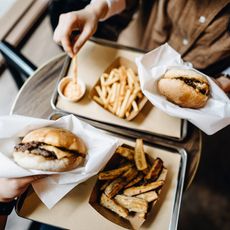 These 8 Foods Are the Worst for Rosacea—Here's What to Eat Instead
These 8 Foods Are the Worst for Rosacea—Here's What to Eat InsteadControl those flare-ups.
By Sarah Yang
-
 15 Things That Cause Bloating and How to Get Rid of It ASAP
15 Things That Cause Bloating and How to Get Rid of It ASAPTry these.
By Sarah Yang
-
 Is the Alkaline Diet Overhyped? What Experts Want You to Know
Is the Alkaline Diet Overhyped? What Experts Want You to KnowHere's how it works.
By Sarah Yang
-
 I'm an Imperfect Dietitian and My Key to Eating Healthy Meals Is Convenience
I'm an Imperfect Dietitian and My Key to Eating Healthy Meals Is ConvenienceTake a peek at my weekly grocery staples.
By Candice Aman
-
 Avoid These 6 Foods—They'll Wreck Your Gut Health
Avoid These 6 Foods—They'll Wreck Your Gut HealthWhat to eat instead.
By Sarah Yang

